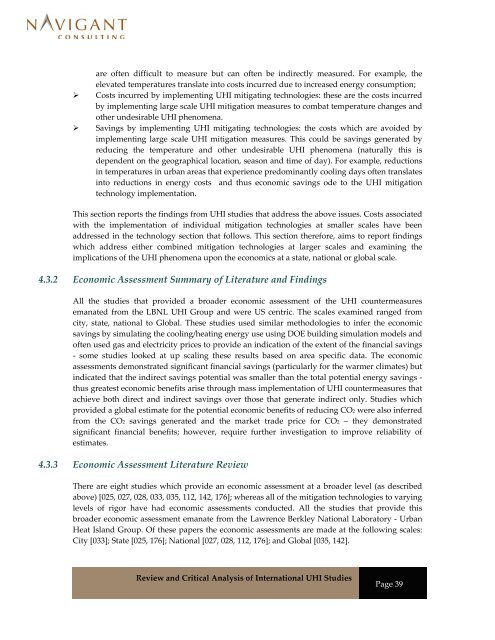Review and Critical Analysis of International UHI Studies
Review and Critical Analysis of International UHI Studies
Review and Critical Analysis of International UHI Studies
Create successful ePaper yourself
Turn your PDF publications into a flip-book with our unique Google optimized e-Paper software.
are <strong>of</strong>ten difficult to measure but can <strong>of</strong>ten be indirectly measured. For example, the<br />
elevated temperatures translate into costs incurred due to increased energy consumption;<br />
� Costs incurred by implementing <strong>UHI</strong> mitigating technologies: these are the costs incurred<br />
by implementing large scale <strong>UHI</strong> mitigation measures to combat temperature changes <strong>and</strong><br />
other undesirable <strong>UHI</strong> phenomena.<br />
� Savings by implementing <strong>UHI</strong> mitigating technologies: the costs which are avoided by<br />
implementing large scale <strong>UHI</strong> mitigation measures. This could be savings generated by<br />
reducing the temperature <strong>and</strong> other undesirable <strong>UHI</strong> phenomena (naturally this is<br />
dependent on the geographical location, season <strong>and</strong> time <strong>of</strong> day). For example, reductions<br />
in temperatures in urban areas that experience predominantly cooling days <strong>of</strong>ten translates<br />
into reductions in energy costs <strong>and</strong> thus economic savings ode to the <strong>UHI</strong> mitigation<br />
technology implementation.<br />
This section reports the findings from <strong>UHI</strong> studies that address the above issues. Costs associated<br />
with the implementation <strong>of</strong> individual mitigation technologies at smaller scales have been<br />
addressed in the technology section that follows. This section therefore, aims to report findings<br />
which address either combined mitigation technologies at larger scales <strong>and</strong> examining the<br />
implications <strong>of</strong> the <strong>UHI</strong> phenomena upon the economics at a state, national or global scale.<br />
4.3.2 Economic Assessment Summary <strong>of</strong> Literature <strong>and</strong> Findings<br />
All the studies that provided a broader economic assessment <strong>of</strong> the <strong>UHI</strong> countermeasures<br />
emanated from the LBNL <strong>UHI</strong> Group <strong>and</strong> were US centric. The scales examined ranged from<br />
city, state, national to Global. These studies used similar methodologies to infer the economic<br />
savings by simulating the cooling/heating energy use using DOE building simulation models <strong>and</strong><br />
<strong>of</strong>ten used gas <strong>and</strong> electricity prices to provide an indication <strong>of</strong> the extent <strong>of</strong> the financial savings<br />
‐ some studies looked at up scaling these results based on area specific data. The economic<br />
assessments demonstrated significant financial savings (particularly for the warmer climates) but<br />
indicated that the indirect savings potential was smaller than the total potential energy savings ‐<br />
thus greatest economic benefits arise through mass implementation <strong>of</strong> <strong>UHI</strong> countermeasures that<br />
achieve both direct <strong>and</strong> indirect savings over those that generate indirect only. <strong>Studies</strong> which<br />
provided a global estimate for the potential economic benefits <strong>of</strong> reducing CO2 were also inferred<br />
from the CO2 savings generated <strong>and</strong> the market trade price for CO2 – they demonstrated<br />
significant financial benefits; however, require further investigation to improve reliability <strong>of</strong><br />
estimates.<br />
4.3.3 Economic Assessment Literature <strong>Review</strong><br />
There are eight studies which provide an economic assessment at a broader level (as described<br />
above) [025, 027, 028, 033, 035, 112, 142, 176]; whereas all <strong>of</strong> the mitigation technologies to varying<br />
levels <strong>of</strong> rigor have had economic assessments conducted. All the studies that provide this<br />
broader economic assessment emanate from the Lawrence Berkley National Laboratory ‐ Urban<br />
Heat Isl<strong>and</strong> Group. Of these papers the economic assessments are made at the following scales:<br />
City [033]; State [025, 176]; National [027, 028, 112, 176]; <strong>and</strong> Global [035, 142].<br />
<strong>Review</strong> <strong>and</strong> <strong>Critical</strong> <strong>Analysis</strong> <strong>of</strong> <strong>International</strong> <strong>UHI</strong> <strong>Studies</strong><br />
Page 39


